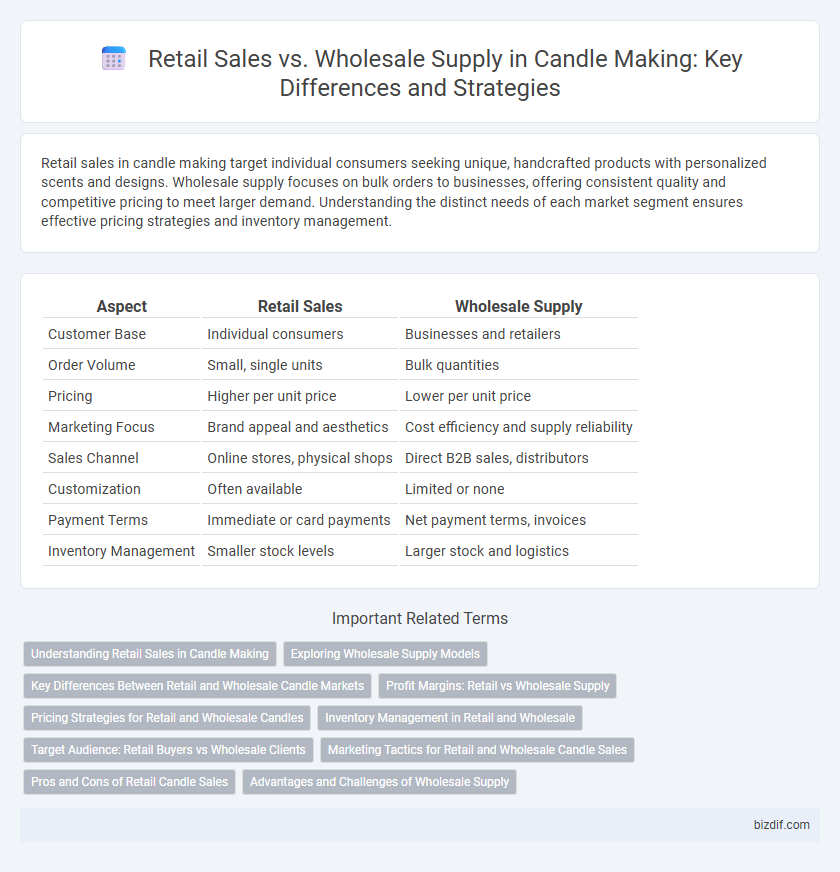Retail sales in candle making target individual consumers seeking unique, handcrafted products with personalized scents and designs. Wholesale supply focuses on bulk orders to businesses, offering consistent quality and competitive pricing to meet larger demand. Understanding the distinct needs of each market segment ensures effective pricing strategies and inventory management.
Table of Comparison
| Aspect | Retail Sales | Wholesale Supply |
|---|---|---|
| Customer Base | Individual consumers | Businesses and retailers |
| Order Volume | Small, single units | Bulk quantities |
| Pricing | Higher per unit price | Lower per unit price |
| Marketing Focus | Brand appeal and aesthetics | Cost efficiency and supply reliability |
| Sales Channel | Online stores, physical shops | Direct B2B sales, distributors |
| Customization | Often available | Limited or none |
| Payment Terms | Immediate or card payments | Net payment terms, invoices |
| Inventory Management | Smaller stock levels | Larger stock and logistics |
Understanding Retail Sales in Candle Making
Retail sales in candle making involve selling finished products directly to consumers, often through physical stores, online shops, or craft fairs. This approach requires attention to packaging, branding, and customer preferences to enhance purchase appeal and repeat business. Retail offers higher profit margins per unit but demands significant marketing efforts and inventory management compared to wholesale supply.
Exploring Wholesale Supply Models
Wholesale supply models in candle making focus on bulk production and distribution to retailers at discounted rates, enabling economies of scale and consistent product availability. Retail sales often involve higher per-unit prices, personalized customer service, and direct brand engagement, targeting end consumers. Exploring wholesale supply allows candle makers to expand market reach, stabilize cash flow, and streamline inventory management through partnerships with retailers and distributors.
Key Differences Between Retail and Wholesale Candle Markets
Retail candle sales target individual consumers seeking small quantities with diverse scents and designs, often focusing on packaged presentation and branded experience. Wholesale candle supply involves bulk transactions with retailers or businesses, emphasizing lower per-unit costs, consistent quality, and scalable production. Pricing strategies differ significantly, with retail prices higher due to marketing and convenience, while wholesale prices are competitive to encourage large volume purchases.
Profit Margins: Retail vs Wholesale Supply
Retail sales of candles typically yield higher profit margins, often ranging between 50% to 70%, due to direct consumer pricing and smaller volume sales. Wholesale supply operates on lower margins, frequently between 20% to 40%, but compensates with bulk orders and consistent demand from retailers or distributors. Optimizing profit margins involves balancing retail markups with wholesale volume discounts to maximize overall business revenue.
Pricing Strategies for Retail and Wholesale Candles
Retail candle pricing typically includes higher markups to cover packaging, branding, and customer experience, often ranging from 50% to 100% profit margins. Wholesale candle pricing favors volume sales with lower per-unit costs, commonly offering 30% to 50% discounts off retail prices to attract bulk buyers and maintain competitive industry standards. Effective pricing strategies balance profitability with market demand, leveraging tiered pricing and minimum order quantities to optimize revenue across both retail and wholesale channels.
Inventory Management in Retail and Wholesale
Effective inventory management in retail candle sales requires maintaining optimal stock levels to meet customer demand while minimizing overstock and stockouts, ensuring a diverse product range including popular scents and seasonal items. Wholesale supply demands managing bulk inventory with accurate forecasting to support larger order volumes and timely replenishment, often leveraging advance orders and supplier relationships to optimize cash flow and storage space. Both channels benefit from integrated inventory systems that track sales trends and turnover rates, enhancing decision-making for procurement and stock rotation.
Target Audience: Retail Buyers vs Wholesale Clients
Retail sales of candles primarily target individual consumers seeking unique, handcrafted scents and personalized designs for home decor or gifts, driving demand for smaller quantities with higher margins. Wholesale supply caters to bulk buyers such as boutiques, event planners, and corporate clients who prioritize consistent quality and cost-effectiveness for large orders. Understanding the distinct purchasing behaviors and volume requirements of retail buyers versus wholesale clients is crucial for optimizing production, pricing strategies, and marketing efforts in the candle making industry.
Marketing Tactics for Retail and Wholesale Candle Sales
Retail candle sales benefit from targeted visual merchandising and social media campaigns that highlight unique scents and seasonal collections, attracting individual consumers. Wholesale supply relies on building relationships with retailers through bulk discounts, branded packaging options, and consistent product quality to ensure sustained orders. Effective marketing tactics for wholesale emphasize brand reliability and scalability, while retail marketing focuses on sensory experience and lifestyle appeal.
Pros and Cons of Retail Candle Sales
Retail candle sales offer higher profit margins per unit by targeting direct consumer purchases, enhancing brand visibility and customer loyalty through personalized service. However, retail requires greater investment in marketing, storefront or e-commerce management, and handling small, frequent transactions. Limited sales volume compared to wholesale can also restrict scalability and increase inventory challenges.
Advantages and Challenges of Wholesale Supply
Wholesale supply in candle making offers advantages such as bulk purchasing discounts, consistent inventory for retailers, and streamlined distribution channels that reduce overall costs. Challenges include managing large order volumes, maintaining quality control across batches, and navigating complex logistics to ensure timely deliveries. Establishing strong relationships with manufacturers is crucial for balancing supply chain efficiency and meeting market demand.
Retail sales vs Wholesale supply Infographic

 bizdif.com
bizdif.com